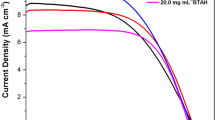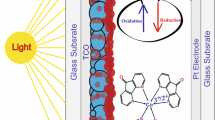Abstract
Co-sensitization of metal-free (Eosin and Coumarin) and metal-based (N3 and N719) organic dye combinations were employed with TiO2 nanoparticles based photoanodes for the fabrication of dye-sensitized solar cells. The charge injection and oxidized dye regeneration process in mono and co-sensitized system were explored from the constructed energy level diagram using cyclic voltammetry analysis. Electrochemical impedance measurements were performed to determine interfacial charge transfer kinetics such as chemical capacitance, recombination resistance and electron lifetime. Current density–Voltage (J–V) characteristics resulted an improved efficiencies in co-sensitized DSSCs due to increased short circuit current density (Jsc). The studies on polarization effect was also evaluated using conductivity plot of impedance spectroscopy. Here, we report for the first time, the internal polarization of dye-sensitizers contributes a small current in the total obtained current density (Jsc) of a device besides the conduction current which enhances the PCE. Especially, high polarization effect of coumarin dye by its resonance polar structure increasing the conductivity in intermediate frequency region of conductivity plot and thus the current density gets enhanced. Improved efficiency of ~ 5.4% was realized in pure metal-based dye co-sensitization by its optimized electron concentration in CB TiO2 to balance charge injection and recombination.








Similar content being viewed by others
References
M. Grätzel, Solar energy conversion by dye-sensitized photovoltaic cells. Inorg. Chem. 44(20), 6841–6851 (2005). https://doi.org/10.1021/ic0508371
Y.-S. Yen, H.-H. Chou, Y.-C. Chen, C.-Y. Hsu, J.T. Lin, Recent developments in molecule-based organic materials for dye-sensitized solar cells. J. Mater. Chem. 22(18), 8734–8747 (2012). https://doi.org/10.1039/c2jm30362k
K.A. Kumar, K. Subalakshmi, J. Senthilselvan (2016) Co-sensitization of natural dyes for improved efficiency in dye-sensitized solar cell application. AIP conference proceedings 1731 (1):060017. https://doi.org/10.1063/1.4947823
K. Ashok Kumar, J. Manonmani, J. Senthilselvan, Effect on interfacial charge transfer resistance by hybrid co-sensitization in DSSC applications. J. Mater. Sci. Mater. Electron. 25(12), 5296–5301 (2014). https://doi.org/10.1007/s10854-014-2304-5
K.A. Kumar, K. Subalakshmi, J. Senthilselvan, Effect of mixed valence state of titanium on reduced recombination for natural dye-sensitized solar cell applications. J. Solid State Electrochem. 20(7), 1921–1932 (2016). https://doi.org/10.1007/s10008-016-3191-x
P. Zuo, C. Li, Y.-S. Wu, X.-C. Ai, X.-S. Wang, B.-W. Zhang, J.-P. Zhang, Mechanism of squarylium cyanine and Ru(dcbpy)2(NCS)2 co-sensitization of colloidal TiO2. J. Photochem. Photobiol. A 183(1–2), 138–145 (2006). https://doi.org/10.1016/j.jphotochem.2006.03.007
G.D. Sharma, S.P. Singh, R. Kurchania, R.J. Ball, Cosensitization of dye sensitized solar cells with a thiocyanate free Ru dye and a metal free dye containing thienylfluorene conjugation. RSC Adv. 3(17), 6036–6043 (2013). https://doi.org/10.1039/c3ra23155k
V. Saxena, P. Veerender, A. Gusain, P. Jha, J. Singh, S.P. Koiry, P.V. Varde, A.K. Chauhan, D.K. Aswal, S.K. Gupta, Co-sensitization of N719 and RhCL dyes on carboxylic acid treated TiO2 for enhancement of light harvesting and reduced recombination. Org. Electron. 14(11), 3098–3108 (2013). https://doi.org/10.1016/j.orgel.2013.07.020
S.P. Singh, M. Chandrasekharam, K.S.V. Gupta, A. Islam, L. Han, G.D. Sharma, Co-sensitization of amphiphilic ruthenium (II) sensitizer with a metal free organic dye: Improved photovoltaic performance of dye sensitized solar cells. Org. Electron. 14(5), 1237–1241 (2013). https://doi.org/10.1016/j.orgel.2012.12.014
C.M. Cardona, W. Li, A.E. Kaifer, D. Stockdale, G.C. Bazan, Electrochemical considerations for determining absolute frontier orbital energy levels of conjugated polymers for solar cell applications. Adv. Mater. 23(20), 2367–2371 (2011)
Y.-S. Yen, T.-Y. Lin, C.-Y. Hsu, Y.-C. Chen, H.-H. Chou, C. Tsai, J.T. Lin, A remarkable enhancement of efficiency by co-adsorption with CDCA on the bithiazole-based dye-sensitized solar cells. Org. Electron. 14(10), 2546–2554 (2013). https://doi.org/10.1016/j.orgel.2013.06.026
A. Mishra, M.K.R. Fischer, P. Bäuerle, Metal-free organic dyes for dye-sensitized solar cells: from structure: property relationships to design rules. Angew. Chem. Int. Ed. 48(14), 2474–2499 (2009). https://doi.org/10.1002/anie.200804709
J. Zhang, C. Yu, L. Wang, Y. Li, Y. Ren, K. Shum, Energy barrier at the N719-dye/CsSnI3 interface for photogenerated holes in dye-sensitized solar cells. Sci. Rep. 4, 6954 (2014). https://doi.org/10.1038/srep06954
S. Hwang, J.H. Lee, C. Park, H. Lee, C. Kim, C. Park, M.-H. Lee, W. Lee, J. Park, K. Kim, N.-G. Park, C. Kim (2007) A highly efficient organic sensitizer for dye-sensitized solar cells. Chem. Commun. 46:4887–4889. https://doi.org/10.1039/b709859f
S.H. Lee, D.H. Nam, J.H. Kim, J.O. Baeg, C.B. Park, Eosin Y-sensitized artificial photosynthesis by highly efficient visible-light-driven regeneration of nicotinamide cofactor. Chembiochem 10(10), 1621–1624 (2009)
K. Ashok Kumar, D. Ramesh, M. Gunaseelan, K. Subalakshmi, J. Senthilselvan, Structural, optical and impedance studies of hydrothermally and solvothermally prepared SnO2 nanocrystallites for conducting electrode application. Trans. Indian Inst. Met. 68(2), 221–225 (2015). https://doi.org/10.1007/s12666-015-0563-3
H. Ding, S. Zhang, J.-T. Chen, X.-P. Hu, Z.-F. Du, Y.-X. Qiu, D.-L. Zhao, Reduction of graphene oxide at room temperature with vitamin C for RGO–TiO2 photoanodes in dye-sensitized solar cell. Thin Solid Films 584, 29–36 (2015). https://doi.org/10.1016/j.tsf.2015.02.038
R.H. Gonçalves, W.H. Schreiner, E.R. Leite, Synthesis of TiO2 nanocrystals with a high affinity for amine organic compounds. Langmuir 26(14), 11657–11662 (2010). https://doi.org/10.1021/la1007473
N.S.K. Kumar, T.S. Shahid, G. Govindaraj, Analysis of conductivity and dielectric spectra of Mn0.5Zn0.5Fe2O4 with coupled cole–cole type anomalous relaxations. Phys. B 488, 99–107 (2016). https://doi.org/10.1016/j.physb.2016.02.018
N.H. Ayachit, D.K. Deshpande, M.A. Shashidhar, K.S. Rao, Determination of excited state electric dipole moment of a molecule from solvatochromic shift measurements-a new approach. Spectrochim. Acta Part A 42(12), 1405–1406 (1986). https://doi.org/10.1016/0584-8539(86)80253-7
M. Pan, N. Huang, X. Zhao, J. Fu, X. Zhong, Enhanced efficiency of dye-sensitized solar cell by high surface area anatase-TiO2-modified P25 paste. J. Nanomater. 2013, 6 (2013)
D. Wang, W. Wang, X. Ma, C. Zhang, J. Zhao, X. Zhang, Comparative study on the influence of TiO2 precursors on ZnO-based dye-sensitized solar cells. Ind. Eng. Chem. Res. 54(50), 12639–12645 (2015)
S.P. Lim, A. Pandikumar, H.N. Lim, R. Ramaraj, N.M. Huang, Boosting photovoltaic performance of dye-sensitized solar cells using silver nanoparticle-decorated N,S-Co-doped-TiO2 photoanode. Sci. Rep. 5, 11922 (2015)
K.S. Anuratha, N. Lakshminarasimhan, Role of synthesis medium of TiO2 nanoparticles in enhancing the open circuit voltage and efficiency in dye-sensitized solar cell. J. Solid State Electrochem. 18(12), 3407–3414 (2014)
Y. Numata, A. Islam, K. Sodeyama, Z.-H. Chen, Y. Tateyama, L. Han, Substitution effects of Ru-terpyridyl complexes on photovoltaic and carrier transport properties in dye-sensitized solar cells. J. Mater. Chem. A 1(36), 11033–11042 (2013). https://doi.org/10.1039/C3TA12152F
Y. Numata, I. Ashraful, Y. Shirai, L. Han, Preparation of donor-acceptor type organic dyes bearing various electron-withdrawing groups for dye-sensitized solar cell application. Chem. Commun. 47(21), 6159–6161 (2011). https://doi.org/10.1039/C1CC11130B
N.C.D. Nath, J.C. Kim, K.P. Kim, S. Yim, J.-J. Lee, Deprotonation of N3 adsorbed on TiO2 for high-performance dye-sensitized solar cells (DSSCs). J. Mater. Chem. A 1(43), 13439–13442 (2013). https://doi.org/10.1039/C3TA12298K
Acknowledgements
This work was supported by University Grants Commission (UGC-India) Research funding [Grant No.: 41-915/2012 (SR); Dt-26 July 2012]. The authors thanks UGC-India for the financial support and Centre for Nano Science and Engineering (CeNSE), Indian Institute of Science, Bangalore, India for the photovoltaic (J–V) measurements.
Author information
Authors and Affiliations
Corresponding author
Electronic supplementary material
Below is the link to the electronic supplementary material.
Rights and permissions
About this article
Cite this article
Ashok Kumar, K., Subalakshmi, K., Karl Chinnu, M. et al. Polarization effect of dye-sensitizers on the current density and photovoltaic efficiency of co-sensitized DSSCs using metal-free and metal-based organic dyes. J Mater Sci: Mater Electron 30, 230–240 (2019). https://doi.org/10.1007/s10854-018-0285-5
Received:
Accepted:
Published:
Issue Date:
DOI: https://doi.org/10.1007/s10854-018-0285-5




